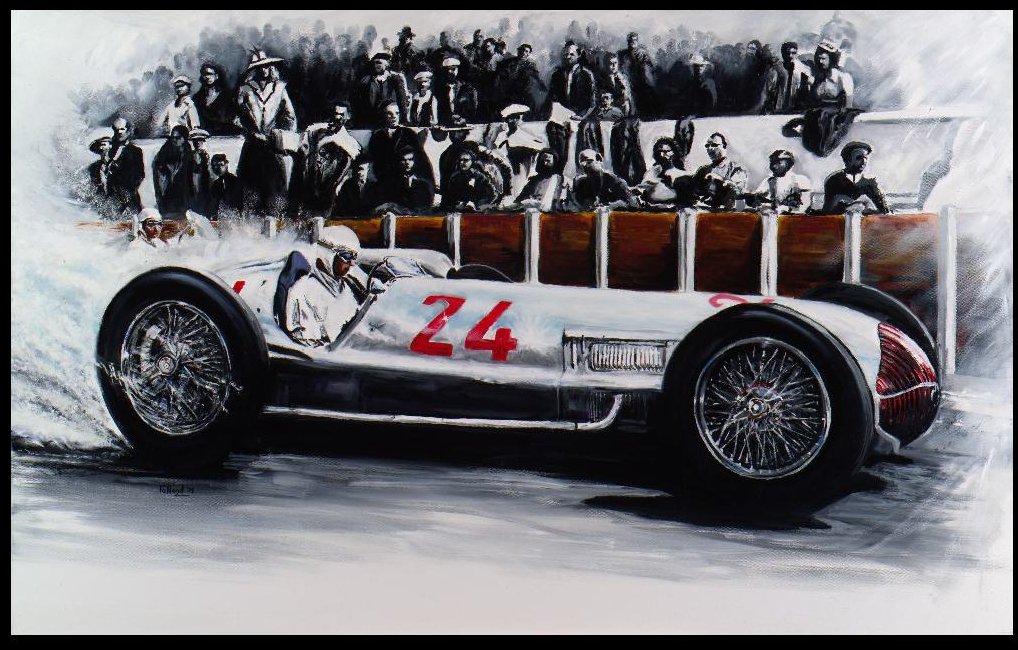"Surprise Victory"Hermann Lang W154 Mercedes-Benz COPPA CIANO, LIVORNO 7TH AUG 1938 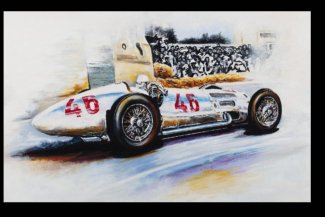 Original oil on canvas Limited edition prints available
Original oil on canvas. SOLD Limkited edition prints available
Rudolf Caracciola powers away from the start line in his fabulous Mercedes 154 at the French Grand Prix, Rheims, 3rd July 1938. The Mercedes team dominated the race and finished 1, 2 and 3. All three drivers led the race at one stage, with Von Brauchitsch being first to the chequered flag. The only other finisher was R. Carriere’s Talbot. 'FLIGHT OF THE SILVER ARROW' 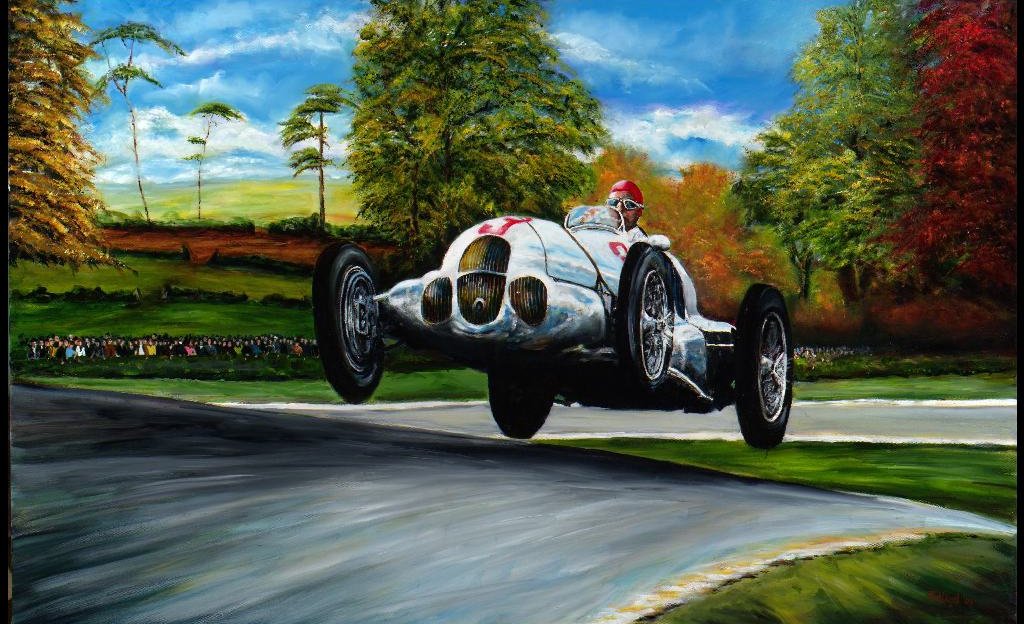 Original oil on canvas Limikted edition prints available
Donington 2nd October 1937. An account of this race was my boyhood introduction to the mighty Silver Arrows, and especially the Mercedes W125 - the most powerful Grand Prix car until the advent of the modern turbo era. Within that account is a stunning photograph with a caption: “Lap after lap, Brauchitsch was bringing the big Mercedes through Coppice Corner in exuberant but fully controlled power slides, to the delight of the crowd.” This was his undoing, for tyre stops would cost him the race which was won by Bernd Rosemeyer (Auto Union). Von Brauchitsch would, however, claim the lap record at 85.62 m.p.h. The painting shows the German at the spectacular “Deer’s Leap”. SILVER ARROWS - NURBURGRINGGerman Grand Prix, Nurburgring, Nordschleife, July 24th 1938. I have chosen to paint two scenes from this particularly exciting and significant race; exciting because of a series of incidents, from a failure of the start lights, a fire in the pits, and a crash at the Flugplatz by ‘the Unlucky Bird’ (the nickname of Brauchitsch). Significant because this was undoubtedly the finest race of Britain’s premier pre-war racing driver, Dick Seaman. Taking place in the Nurburgring only one year before the outbreak of World War II, against a background of rising Nazism, this win by a British driver over the German, Manfred Von Brauchitsch, on his home ground, resonated well beyond the world of Grand Prix racing. 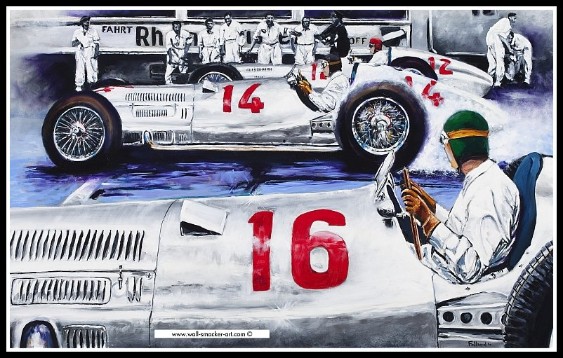 Lang’s wheel s are spinning as he makes his speedy getaway, whilst Dick Seaman is left staring at the start lights, which had failed at the crucial moment, leaving him literally ‘caught napping’. Von Brauchitsch also stutters at the start.
'CARPE DIEM'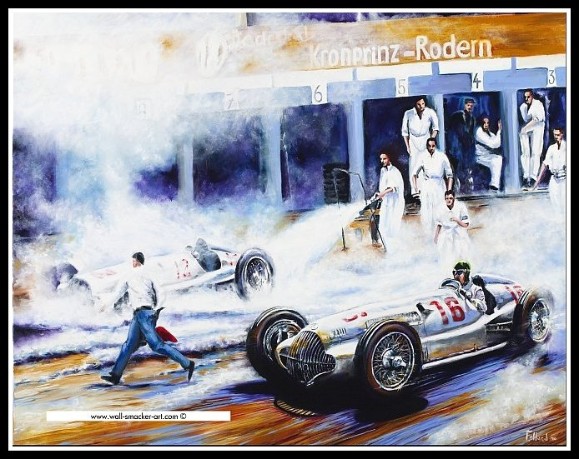 I have entitled the second painting Carpe Diem, as it depicts the moment at which Dick Seaman seizes his day by grasping the opportunity presented by Brauchitsch’s pit disaster. I can explain this no better than by quoting from the excellent book by Doug Nye and Geoffrey Goddard, entitled 'Dick and George’, which is based on correspondence between Dick Seaman and George Monkhouse. “On lap sixteen, Brauchitsch surged into the pits for a second fresh set of wheels and fuel. Dick followed him for fuel, but with his tyres sufficiently sound not to be changed. The mechanic refuelling Brauchitsch’s car was just fractionally late in closing the feed hoses’ stop-dash. Instantaneously, the acetone-rich fuel mix vomited back from the vast gaping filler neck just behind Brauchitsch’s red-leather capped head. It cascaded over the car’s tail, splattering down onto the pit apron. Standard practice for such a spillage was then to dilute it with water thrown from a handy bucket before the car’s engine would be restarted, but in their haste to return Brauchitsch to his home race, the mechanics restarted the engine immediately. A stab of exhaust flame instantly ignited the spilled fuel. Since it was alcohol-based, it blazed invisibly – just a sinister, shimmering vale of searing heat billowing around the car. Brauchitsch jabbed at his steering wheel’s release button, flung the wheel high and handsome, and hurled himself from the cockpit. Just yards behind the blazing car, Dick found his mechanics “so busy looking at this fire that they somewhat forgot about me, but I shouted ‘Hey!’, and then they pushed me back out of the way. I put the wheels over to full lock. The engine was started, and, ducking as I went past the flames and smoke, I got away”. "No British driver had won a premier-league Grand Prix for fifteen long years – not since his own hero, Henry Segrave, in a Sunbeam, had won the 1923 French Grand Prix at Tours.” “Dick and George”, Doug Nye and Geoffrey Goddard, Palawen press, 2002.
|
